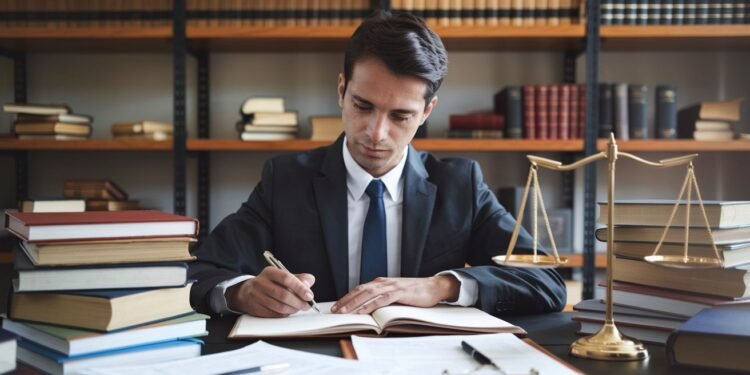Author: Anshika Agarwal 3rd Semester- BBALLB Vivekananda Institute of Professional Studies
Introduction
The intersection of music copyright and streaming services has significantly transformed the music industry, presenting both opportunities and challenges. Copyright protects the original works of creators, encompassing musical compositions and sound recordings, thereby granting exclusive rights to reproduce, distribute, and perform their music. Streaming platforms like Spotify, Apple Music, and Amazon Music have revolutionized music consumption, requiring these services to secure complex licensing agreements with record labels, music publishers, and performance rights organizations (PROs) to legally stream copyrighted music. However, this model has sparked debates over fair compensation, as artists often receive lower per-stream payouts compared to traditional sales, leading to concerns about the adequacy of royalty distribution. Furthermore, the rise of user-generated content platforms complicates copyright enforcement, necessitating innovative licensing strategies to protect artists’ rights while adapting to evolving consumer behaviors. Recent legislative changes and advocacy efforts emphasize the need for fairer compensation and better copyright protection in the digital age, underscoring the importance of adapting to this rapidly evolving landscape.
The convergence of music copyright and streaming services has greatly altered the music landscape, offering both benefits and obstacles. Copyright safeguards the original creations of artists, including musical compositions and sound recordings, thus providing exclusive rights to reproduce, distribute, and perform their music. Streaming services such as Spotify, Apple Music, and Amazon Music have changed how people consume music, necessitating these platforms to obtain intricate licensing agreements with record labels, music publishers, and performance rights organizations (PROs) to stream copyrighted music legally. However, this arrangement has ignited discussions about fair compensation, as artists typically earn lower payouts per stream compared to conventional sales, raising issues about the fairness of royalty distribution. Additionally, the emergence of user-generated content platforms complicates the enforcement of copyright, requiring creative licensing approaches to safeguard artists’ rights while adjusting to changing consumer habits. Recent changes in legislation and advocacy initiatives highlight the necessity for improved compensation and enhanced copyright protection in the digital era, stressing the need to adapt to this swiftly changing environment.
Copyright Process In India
Copyright is a right given by the law to creators of literary, dramatic, musical and artistic works and producers of cinematograph films and sound recordings. In fact, it is a bundle of rights including, inter alia, rights of reproduction, communication to the public, adaptation and translation of the work. There could be slight variations in the composition of the rights depending on the work.Copyright ensures certain minimum safeguards of the rights of authors
over their creations, thereby protecting and rewarding creativity. Creativity being the keystone of progress, no civilized society can afford to ignore the basic requirement of encouraging the same. Economic and social development of a society is dependent on creativity. The protection provided by copyright to the efforts of writers, artists, designers, dramatists, musicians, architects and producers of sound recordings, cinematograph films and computer software, creates an atmosphere conducive to creativity, which induces them to create more and motivates others to create
The copyright process for music in India is primarily regulated by the Copyright Act of 1957, which offers a thorough legal structure for protecting original creations, including musical works and audio recordings. Copyright protection takes effect automatically when a musical piece is created and recorded in a permanent format, such as via a recording or written score. To strengthen legal safeguards and aid in enforcement, creators have the option to register their works with the Copyright Office, though registration is not essential for copyright validity. This process requires submitting an application with relevant documentation, including information about the work, details of the creator, and a fee. Registration acts as prima facie proof of ownership, which streamlines the resolution of disputes over rights in the event of infringement. The underlying intention of the copyright system is to motivate creativity by allowing artists, composers, and producers to control the usage of their creations and receive fair payment. By protecting their rights, copyright law fosters the development of a varied musical landscape, enriching India’s cultural scene while enabling artists to earn a living from their artistry. As the digital environment continues to change, with the growth of streaming platforms and user generated content, the importance of effective copyright enforcement and awareness among creators has become increasingly crucial to safeguard their intellectual property rights and ensure appropriate compensation.
In addition to the Copyright Act of 1957, which serves as the cornerstone of music copyright protection in India, several other acts and legal frameworks contribute to the broader landscape of intellectual property rights impacting the music industry. The Trademarks Act, 1999, plays a crucial role by allowing artists and musicians to register and protect their distinctive brand identities, such as stage names and logos, thereby preventing unauthorized use by others and helping to maintain their unique market presence. The Patents Act, 1970 , although primarily focused on inventions, can influence the music sector by protecting technological innovations related to music production, sound engineering, and recording techniques, thus fostering creativity and innovation. Furthermore, the Information Technology Act, 2000 addresses issues of copyright infringement in the digital realm, outlining the responsibilities of online intermediaries, such as streaming services and social media platforms, in safeguarding copyrighted material and curbing unauthorized distribution. The Performers’ Rights (Amendment) Act, 2012 enhances protections for artists by granting them rights over the commercial use of their performances, ensuring they receive appropriate royalties when their work is broadcasted or reproduced. Additionally, India’s commitment to international copyright
treaties like the Berne Convention and the TRIPS Agreement establishes global standards for copyright protection and enforcement, reinforcing the legal framework for music copyright. Collectively, these acts ensure a multifaceted approach to intellectual property rights, safeguarding the interests of creators and promoting a healthy ecosystem for artistic expression and innovation in the music industry.
Challenges Faced in Music Copyright
In India, copyrighting music involves various legal hurdles that can make the process challenging for creators. One significant concern is the widespread lack of understanding and awareness among many artists, particularly independent musicians, regarding their rights and the complexities of copyright legislation. This lack of knowledge can result in unintentional violation of others’ copyrights or a failure to safeguard their own creations. Furthermore, the intricacies of licensing agreements can complicate negotiations, often necessitating legal knowledge that many artists do not possess, which could lead to unfavorable agreements. The prevalence of piracy and unauthorized online music usage worsens the situation, as digital platforms allow for extensive distribution of copyrighted works without appropriate permissions, severely affecting artists’ income. Additionally, difficulties in enforcement arise when copyright owners seek to pursue infringement actions, as legal processes can be prolonged and expensive, placing smaller artists at a disadvantage. Uncertainties in the Copyright Act of 1957 itself, especially concerning the concepts of originality and moral rights, can cause varying interpretations and legal conflicts. The globalization of music also introduces difficulties, as artists must navigate different copyright regulations across various regions, complicating international enforcement.
Even copyrighting is a difficult process and is not as easy as it looks. Many musicians, especially those who are independent or new to the industry, often lack a comprehensive understanding of copyright laws and their associated rights. This gap in knowledge can lead to unintentional infringements, where artists may unknowingly use copyrighted material without permission, exposing them to potential legal repercussions. Furthermore, many creators may not realize the importance of registering their works or understanding the scope of their rights, including moral rights, which can result in diminished control over their creations. Education and awareness initiatives are crucial to empower artists to navigate the complex copyright landscape effectively. Negotiating licensing agreements can be a daunting task for artists who may not have legal training. These agreements often contain intricate legal jargon and clauses that can significantly affect the artist’s rights and revenue. For instance, artists might agree to grant exclusive rights to their music without fully understanding the implications, such as losing the ability to license their work to other platforms or earn royalties from different uses. This complexity can lead to unfavorable terms that do not adequately compensate artists for their work, especially in an industry where financial literacy is not widespread.While copyright holders have the right to enforce their copyrights, doing so can be legally and financially challenging. The process of pursuing legal action against infringers can be time-consuming and costly, often deterring
smaller artists from taking action. Legal proceedings may require extensive documentation, expert testimony, and prolonged court battles, which can drain resources and distract artists from their creative endeavors. Additionally, the effectiveness of enforcement can vary, leading to inconsistent outcomes that may not adequately address the harm caused by infringement .Despite several amendments to the Copyright Act of 1957, ambiguities still exist in the law. Key issues such as the definition of “originality,” the extent of moral rights, and the specifics of digital distribution can lead to differing interpretations and legal disputes. For example, what constitutes “originality” in a musical composition may be subjective, resulting in challenges when determining whether a work infringes on another. Such ambiguities can create uncertainty for creators, potentially discouraging them from pursuing their rights or engaging in creative endeavors. These legal challenges highlight the need for ongoing education, advocacy, and reform within the music copyright landscape in India. Addressing these issues is essential for creating a more equitable environment for artists and ensuring they are adequately protected and compensated for their creative works. By enhancing awareness, simplifying licensing processes, improving enforcement mechanisms, and fostering fair practices within collective rights management, the music industry can better support its creators and promote a vibrant cultural landscape.
A Way Ahead to Cater to these Challenges
To address the legal challenges faced in music copyright in India, a multi-faceted approach is necessary. Education and awareness initiatives should be implemented to inform artists, especially independent musicians, about their rights and the importance of copyright protection. Workshops, online courses, and accessible resources can empower creators with knowledge about registration processes, licensing agreements, and enforcement mechanisms. Simplifying licensing agreements is also crucial; legal frameworks could be established that standardize contracts, making them easier to understand for non-lawyers and ensuring that artists retain fair rights over their works. Strengthening enforcement mechanisms through the establishment of dedicated copyright enforcement units can help combat piracy and unauthorized use, enhancing monitoring and swift legal action against infringers. Additionally, updating copyright laws to address the challenges posed by technological advancements is vital; this could involve creating clear guidelines for digital distribution and usage that reflect current industry practices. Enhancing transparency in collective rights management organizations can ensure that royalties are distributed fairly, allowing artists to receive accurate and timely payments. Furthermore, collaboration with international bodies can help Indian artists navigate global copyright issues more effectively, providing resources and support for enforcing their rights across borders. By implementing these solutions, India can create a more equitable and sustainable environment for music creators, fostering innovation and protecting their creative contributions.



